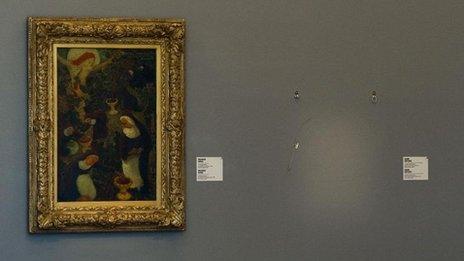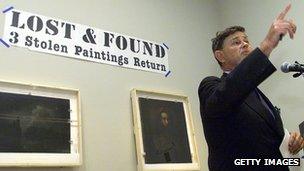Thieves fail to profit from stolen works of art
- Published

Rotterdam's Kunsthal art gallery lost a number of valuable paintings last month
Despite the global financial downturn and all the current talk about austerity, affluent art lovers have been snapping up old masters and contemporary art in record-breaking auctions throughout the year.
But do the buyers see their purchase as a profitable investment opportunity, or is it just a status symbol?
The idea of art being an asset is not a new one.
One of the first art funds in existence came about in Paris in 1910, when a group of people invested the relatively small amount of 750 francs each to purchase works by Picasso and Matisse, which they sold 10 years later for 100,000 francs - thereby making a handsome profit.
A more recent example would be the rock guitarist Eric Clapton selling a painting by Gerhard Richter for $30m, which was 10 times the price he paid for it.
However, according to Thomas Galbraith, director of global strategy at the website Artnet, which tracks sales at auctions around the world: "If you were to flick though an auction catalogue from 1980 or 1985 you would find a lot of artists you don't recognise because, although they were selling then, the market for them didn't hold up."
Some $60bn (£38bn) of art was sold in 2011 - half of which was at auctions and the other due to half private sales.
But will the work of the more conceptual artists such as Damien Hirst retain the longevity of the Renaissance masters?
"When you look at artists over time, they are routinely at the cutting edge of using technology as it comes out," says Mr Galbraith.
He notes that impressionists used pigments in oil, which was a new medium at the time. "The medium is ephemeral. The artist just chooses which medium to work with," he says.
The work by artists such as Kac, who bio-engineers creatures and produced a fluorescent rabbit, is one of the harder things to sell.
"There is more than one art market," he says, "When we are looking at these different things we talk about the art market as a whole, but that is like asking how the financial markets are doing."
'Worthless canvas'
It is commonplace now for a work of art to be worth tens of millions of dollars, and that makes them a target for art thieves.
It is frequently depicted as one of the most glamorous crimes, especially in film, where the plot concentrates on elaborate security measures and fast getaway cars.
But there is a flaw in every great heist which none of the films ever seem to acknowledge - despite the huge risks the criminals take and the value of the stolen art, they never make much money.

Eric Clapton made a big profit on Gerhard Richter's Abstraktes Bild
"Nine times out of ten, when individuals commit a robbery like that, it is done by individuals or criminal organisations which have the ability to do a burglary, but they don't usually have the ability to sell paintings," says Robert Wittman, founder of the FBI's art crime team and author of the memoir Priceless: How I Went Undercover to Rescue the World's Stolen Treasures.
In his experience, people often did a good job of figuring out how to commit the crime, but never did a good job making money from it.
Ransom
He recalls that in 2000, three individuals went into the National Museum in Stockholm and stole two Renoirs and a Rembrandt self-portrait worth $42m. They arranged for car bombs to go off to prevent access by the police and escaped in a high-speed boat.

Most stolen paintings find their way back to the museums because they cannot be sold
The paintings were eventually recovered in Sweden, Denmark and the US, so in the end they were unable to monetise any of the stolen works.
Because they are unable to sell the paintings, Mr Wittman says the thieves will often try to hold the works to ransom - especially when rewards are offered for their recovery.
"In the 25 years I have investigated these robberies, I have never heard of anyone actually monetising these very valuable paintings," he says.
"What the thieves do not understand is that the value of artwork comes from authenticity, provenance and legal title," he explains.
"If you don't have one of those three things, all you have is a piece of canvas with some paint on it," he says.
To retrieve stolen paintings, Mr Wittman has often posed as an art dealer. The negotiations, before the stolen object is actually produced and action can be taken, may take anything from two weeks to two years, he says.
"After four paintings were stolen at gunpoint from the Museum of Fine Arts in Nice, on the French Riviera, we had meetings in Miami, Barcelona, Madrid and Marseilles.
"In the end they brought us the paintings to be sold," he says.
With a hint of irony, he adds: "It is not a good crime, it turns you into a terrible businessman."
- Published15 November 2012
- Published20 June 2012
- Published30 January 2012